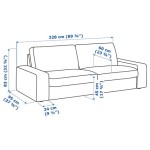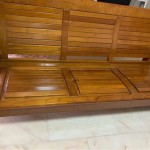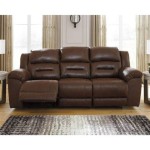One Point Perspective Sofa: Drawing and Understanding
The ability to represent three-dimensional objects on a two-dimensional surface is a fundamental skill in art and design. One-point perspective is a drawing technique that creates a realistic illusion of depth and space. When applied to complex objects like sofas, this method requires careful observation and understanding of spatial relationships. This article explores the principles and practical steps involved in drawing a sofa using one-point perspective.
One-point perspective relies on a single vanishing point located on the horizon line. All lines parallel to the viewer's line of sight converge towards this vanishing point, creating the illusion of objects receding into the distance. The horizon line represents the viewer's eye level, and its placement on the drawing surface dictates the viewing angle of the scene.
Before beginning to draw a sofa in one-point perspective, it’s helpful to visualize the sofa’s basic structure. A sofa can be simplified into a rectangular prism or a combination of several interconnected prisms. This simplification makes it easier to apply the principles of perspective. Identifying the front face of the sofa is crucial, as this will be the starting point of the drawing.
Start by drawing a horizontal line representing the horizon line. The placement of this line determines whether the viewer is looking up at, down at, or directly at the sofa. Next, mark a point on the horizon line; this is the vanishing point. Draw a rectangle representing the front face of the sofa. This rectangle should be positioned below, above, or intersected by the horizon line depending on the desired viewing angle.
Once the front face is established, draw lines from each corner of the rectangle to the vanishing point. These lines represent the edges of the sofa that recede into the distance. These converging lines are known as orthogonal lines. The length of these lines determines the depth and overall length of the sofa in the perspective drawing.
To define the back of the sofa, draw another rectangle parallel to the front face. This rectangle should be positioned along the orthogonal lines. The size of this rectangle, relative to the front face, dictates the depth of the sofa. Connect the corresponding corners of the front and back rectangles to complete the basic structure of the sofa.
Adding details like the arms, cushions, and legs requires careful observation and continued application of the one-point perspective principles. The arms of the sofa, often extending outwards from the front face, will also have lines converging towards the vanishing point. Similarly, the legs, if visible, should be drawn with lines receding towards the same vanishing point.
Representing the cushions requires understanding how they sit within the sofa's structure. While the top surfaces of the cushions might appear relatively flat, their sides and front edges are subject to the rules of perspective. Light lines can be used to indicate the contours and folds of the cushions, further enhancing the three-dimensional illusion.
The thickness of the sofa’s structure, including the arms and back, also needs to be considered. Lines parallel to the front face of the sofa will maintain their parallel orientation in the perspective drawing. However, the length of these lines will appear shorter as they recede towards the vanishing point, creating the illusion of depth.
Practicing with different horizon line placements and vanishing points allows for exploration of various viewpoints and perspectives. A higher horizon line creates a bird’s-eye view, while a lower horizon line results in a worm’s-eye view. The position of the vanishing point also influences the angle from which the sofa is seen.
Understanding the principles of light and shadow is crucial for further enhancing the realism of the drawing. The interplay of light and shadow helps to define the sofa's form and volume. Shading should be consistent with the established light source, with areas facing the light source appearing brighter and areas further away or obscured appearing darker.
Utilizing a ruler to ensure straight lines and carefully measuring proportions greatly contributes to the accuracy and overall impact of the one-point perspective drawing. While freehand sketching can be helpful for initial visualization, using a ruler allows for precise execution of the perspective principles.
Drawing a sofa in one-point perspective provides valuable practice in understanding spatial relationships and translating three-dimensional forms onto a two-dimensional surface. Mastery of this technique not only enhances artistic skills but also strengthens spatial reasoning abilities applicable in various fields, including design, architecture, and engineering.

1 Point Couch Perspective Drawing Architecture

How To Draw A Sofa In One Point Perspective

How To Draw A Sofa Step By Two Point Perspective

How To Draw Sofa In 1 Point Perspective

Step By How To Draw One Point Perspective Couch Drawingtutorials101 Com

How To Draw In One Point Perspective Option2

How To Draw A Sofa Step By Perspective

How To Draw A Room In 1 Point Perspective Easy Step By Drawing Tutorial Tutorials

1 Point Couch Perspective

1 Point Couch Perspective Easy Art Lessons Design Sketch








